Happening Now
You Decide: Top 10 New Trains in the US!
October 1, 2019
Help Rail Passengers decide what are the most exciting potential train services in America
Rail Passengers has been engaging members on our reauthorization plan all year, asking for feedback on our proposed policies. It’s important, however, to take time to think about what these policies would mean for service in your community, and communities across the US. There’s no better way to do that than to look at a map and think: where do we need more train service?
Click here for a high-resolution version of the Vision Map
That’s why we’re asking for you to vote on the 10 most exciting new train services across the US! We’ve identified 31 exciting new routes for the 31 days of October, and we need YOUR vote.
Are you interested in seeing true high-speed rail in Atlanta and across the New South? Restored daily service to the Pioneer route out west? Fast, frequent service from the US to Montreal? Or a high-speed train connecting Southern California to Las Vegas?
We want to know which new corridors and services passengers are most excited about. We’ll share your votes with Congress and Amtrak as they begin writing the new passenger rail bill over the next year.
Corridor |
City Pairs |
Frequency |
Northeast |
||
| Montrealer | New York City - Springfield - St. Albans - Montreal | Regional |
| Lackawanna Cut-Off / Southern Tier New York Corridor | New York City - Scranton - Binghamton - Elmira - Buffalo | Regional |
Mid-Atlantic |
||
| Daily Cardinal | Chicago - Indianapolis - Washington, D.C. - New York City | Daily |
| Virginia Coastal Corridor | Washington, DC - Richmond - Norfolk/Virginia Beach - Newport News | Regional |
| Pennsylvania High-Speed Rail Corridor | New York City - Philadelphia - Harrisburg - Pittsburgh | Core Express |
Southeast |
||
| Southeast High-Speed Rail Corridor | Downtown Atlanta - Charlotte - Richmond | Core Express |
| Florida East Coast Corridor | Jacksonville - Daytona Beach - Miami | Regional |
| Florida West Coast Corridor | Tampa - Sarasota - Fort Myers - Naples | Regional |
| Georgia - Florida High-Speed Rail Corridor | Atlanta - Macon - Jacksonville - Orlando - Tampa | Core Express |
| Southeast Regional Corridor | Birmingham - Atlanta - Athens - Augusta - Greenville | Regional |
| Georgia - Tennessee Corridor | Atlanta - Chattanooga - Nashville - Memphis | Regional |
Southern |
||
| Gulf Coast Restoration | New Orleans - Tallahasee - Jacksonville | Daily |
South Central |
||
| Central Texas Corridor | Wichita - Oklahoma City - Dallas - Austin - San Antonio | Core Express |
| I-20 Corridor | Fort Worth - Dallas - Jackson - Atlanta | Daily |
| Austin - San Antonio Corridor | Austin - San Antonio | Regional |
Midwest |
||
| Madison Rail Corridor | Madison - Milwaukee - Chicago | Core Express |
| Illinois - Ohio Corridor | Chicago - Toledo - Cleveland | Regional |
| Minneapolis/St. Paul - Chicago Rail Corridor | Minneapolis/St. Paul - Milwaukee - Chicago | Regional |
| St. Louis - Chicago High-Speed Rail Corridor | Chicago - St. Louis - Kansas City | Core Express |
| 3C Corridor | Cleveland - Colombus - Cincinnati | Regional |
| Michigan High-Speed Rail Corridor | Chicago - Kalamazoo - Detroit | Core Express |
| Northern Michigan Rail Corridor | Detroit - Lansing - Grand Rapids - Kalamazoo | Regional |
| Chicago - Columbus Corridor | Chicago - Fort Wayne - Columbus | Regional |
| Detroit - Toronto Corridor | Detroit - Toronto | Core Express |
Mountains & Plains |
||
| Front Range Rail | Cheyenne - Ft. Collins - Denver - Pueblo - Trinidad | Regional |
Southwest |
||
| Las Vegas Rail Corridor | Los Angeles - Las Vegas | Core Express |
| Arizona Rail Corridor | Los Angeles - Phoenix - Tuscon | Regional |
| Daily Sunset | New Orleans - San Antonio - El Paso - Maricopa - Los Angeles | Daily |
Northwest |
||
| Pacific Northwest High-Speed Rail Corridor | Portland - Seattle - Vancouver | Core Express |
| Pioneer | Portland - Boise - Salt Lake City | Daily |
| North Coast Hiawatha | Seattle - Missoula - Bismarck - Fargo - Minneapolis - St. Paul | Daily |
Frequency |
||||
|
Definitions |
Top Speed |
Other Common Characteristics |
Primary Markets Served |
Minimum OTP |
|
Core Express |
Over 125mph |
Frequent service; dedicated tracks, except in terminal areas; electric-powered |
Serving major metropolitan centers |
99% |
|
Regional |
90-125mph |
Frequent service; dedicated and shared tracks; Electric- and diesel-powered |
Connecting mid-sized urban areas with each other or with larger metropolitan areas |
95% |
|
Daily |
Up to 90mph |
Shared tracks |
Connecting mid-sized and smaller urban areas with each other or with larger metropolitan areas |
85% |
Northeast
Montrealer
New York City - Springfield - St. Albans - Montreal
Regional
This route would extend Amtrak’s current ‘Vermonter’ service across the US/Canada border into Quebec, terminating at Montreal’s Central Station.
Any such extension and expansion of the current service is predicated upon the establishment of a ‘Pre-Clearance Customs & Immigartion Inspection Facility’ at Montreal’s Central Station. The US and Canadian governments have recently ratified the necessary international treaties making such a facility possible. Funding for the construction and operation of the Inspection facility has yet to be identified.
Expansion of service along New York’s current Adirondack Corridor between New York, Albany and Montreal would also be possible with the new Montreal Inspection capabilities. [VOTE NOW]
---
Lackawanna Cut-Off / Southern Tier New York Corridor
New York City - Scranton - Binghamton - Elmira - Buffalo
Regional
This corridor would start at New York’s Penn Station and serve stations in New Jersey & Pennsylvania on route to Scranton, PA, a distance of approximately 136 miles. The corridor would utilize the ‘Lackawanna Cut-Off’, a 28-mile segment constructed in the early 1900’s specifically for high-speed passenger service. Studies first looked at this potential corridor in the 1990s.
North of Scranton, the corridor would extend 60 miles to Binghamton, NY, before turning west to serve New York’s Southern Tier cities of Elimra & Corning, before reaching New York’s second largest city of Buffalo; Binghamton to Buffalo is a distance of approximately 200 miles.
The last through service along this route ended in the early 1960’s. With the exception of the ‘Lackawanna Cut-Off’ segment, the corridor would use currently-active freight routes. [VOTE NOW]
Mid-Atlantic
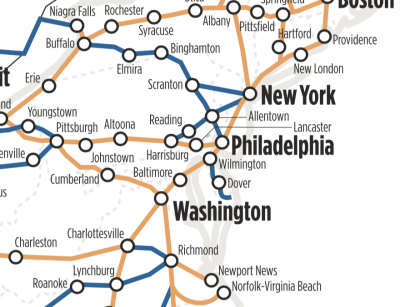
Daily Cardinal
New York City - Washington - Cincinnati - Indianapolis - Chicago
Daily
Expanding Amtrak’s ‘Cardinal’ to be a daily train along the current route serving Charlottesville, VA; Charleston, WV; Ashland, KY; Cincinnati, OH; Indianapolis, IN and many other intermediate stations. [VOTE NOW]
---
Virginia Coastal Corridor
Washington- Richmond - Norfolk/Virginia Beach & Newport News
Regional
Expanding Amtrak’s current, Virginia state-supported services, from Washington to Richmond and then onto Newport News and/or Norfolk/Virginia Beach.
Infrastructure and capacity improvements are currently underway along the Washington to Richmond corridor, allowing for future service expansion. Planning for the replacement of the Long Bridge over the Potomac River, a current choke-point, is progressing. [VOTE NOW]
---
Pennsylvania High-Speed Rail Corridor
New York City - Philadelphia - Harrisburg - Pittsburgh
Core Express
Creation of a dedicated high-speed corridor connecting the Northeast Corridor with Pittsburgh. Route would generally follow the historic Pennsylvania Railroad alignment, but with significant segments of new dedicated right-of-way necessary to increase capacity and reduce trip times. Service to the major population centers along the corridor.
Service to smaller currently-served communities would be via regional trains on the current route, connecting with the high-speed Core Express trains at major stations. [VOTE NOW]
Southeast
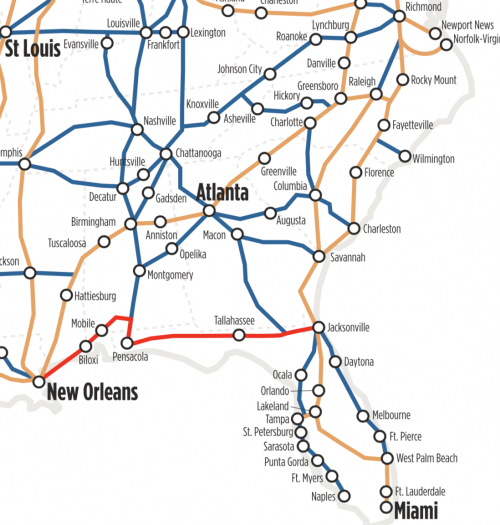
Southeast High-Speed Rail Corridor
Atlanta - Charlotte - Richmond - Washington, D.C.
Core Express
This Richmond - Atlanta rail corridor is currently served by Amtrak’s Crescent. Work done by the FRA, state DOT’s, and Rail Passenger on the Southeast Regional Rail Planning Study helped identify this segment as the central, high-speed rail spine of a future Southeastern rail network.
This corridor would connect the largest economies in the south, bring passenger rail to downtown Atlanta, and eventually tie into the NEC, creating a high-speed rail spine from Boston to Atlanta. [VOTE NOW]
---
Florida East Coast Corridor
Jacksonville - Daytona - Miami
Regional
Florida hasn’t seen passenger rail along the entirety of its East Coast since 1968, when the Florida East Coast Railway discontinued its passenger operations. While Virgin Trains USA’s Brightline has returned passenger service between Miami and West Palm Beach, passenger advocates are still interested in extending service north to Fort Pierce, Daytona, and St. Augustine, eventually connecting back into the National Network at Jacksonville. [VOTE NOW]
---
Florida West Coast Corridor
Tampa - Sarasota - Fort Myers - Naples
Regional
Identified by the Southeast Regional Rail Planning Study, this corridor would build off the existing Amtrak network--and, eventually, Brightline’s Miami - Orlando train, bringing the Gulf-side of the state online--and opening up several key tourist markets in the process. [VOTE NOW]
---
Georgia - Florida High-Speed Rail Corridor
Atlanta - Macon - Jacksonville - Orlando - Tampa
Core Express
The second high-speed rail spine identified by the Southeast Regional Rail Planning Study, this corridor would close a huge gap in the existing national network, allowing direct access for between Florida and Atlanta. This would connect some of the largest economies in the Southeast, while simultaneously expanding access to passenger rail in rural parts of Georgia. [VOTE NOW]
---
Southeast Regional Corridor
Birmingham - Atlanta - Athens - Augusta - Columbia - Greenville
Regional
Identified by the Southeast Regional Rail Planning Study, this would supplement the high-speed Richmond - Atlanta spine, bringing several key cities in Georgia and South Carolina into the National Network, while closing key north-south and east-west gaps in the system. [VOTE NOW]
---
Georgia - Tennessee Corridor
Atlanta - Chattanooga - Nashville- Memphis
Regional
The Southeast Regional Rail Planning Study identified this corridor segment as the northern centerpiece of the Southeast rail network. Atlanta - Nashville would anchor the segment, connecting some of the fastest growing cities in the south. The Nashville - Memphis corridor would eventually tie into the Midwest rail network, helping close a missing link in the National Network. [VOTE NOW]
Southern
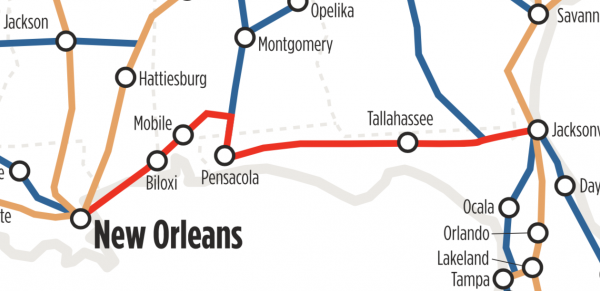
Gulf Coast Restoration
New Orleans, Tallahassee, Jacksonville
Daily
The Gulf Coast rail connection between Florida and Louisiana was knocked out more than a decade by Hurricane Katrina. Since that storm, all modes of transportation crossing the Gulf Coast have been reestablished except for passenger rail.
Led by the Southern Rail Commission, advocates have been working to create a strong, multi-modal transportation network connecting the entire Gulf South with passenger rail service. This train would boost the Gulf Coast economy by connecting growing population centers and tourist destinations. It would also help the 2 million Gulf Coast residents by increasing access to jobs, health care, higher education, beaches, casinos and multiple military bases. [VOTE NOW]
South Central
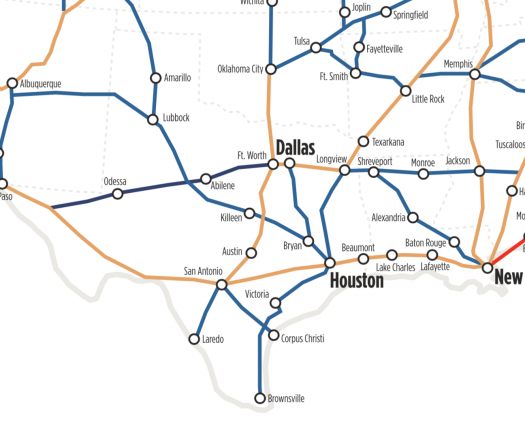
Central Texas Corridor
Wichita - Oklahoma City - Dallas - Austin - San Antonio
Core Express
Texas’ population and economy are booming, with much of its growth occurring in the already-congested I-35 corridor. Texans are increasingly recognizing that there is a limit to how many miles of road they can lay, and are turning to passenger rail to meet the needs of travelers and reduce demand on some of the state’s most congested roadways.
Through the Texas-Oklahoma Passenger Rail Study, TxDOT studied how passenger rail service could address the needs of this 850-mile corridor. TxDOT preferred a mixed corridor, with a high-speed spine between Dallas-Fort Worth and San Antonio, and conventional speed services between DFW and Oklahoma City and San Atonio and South Texas. This corridor will be essential to meeting the needs of the booming Texas population and maintaining the regional economy in the face of growing congestion. [VOTE NOW]
---
I-20 Corridor
Fort Worth - Dallas - Longview - Meridian - Atlanta
Daily
The I-20 Corridor Council was formed to re-establish passenger rail along the Interstate 20 Corridor, extending from Fort Worth, Texas to Atlanta, Georgia, ultimately connecting to New York City. The Corridor now encompasses 35 municipalities in northern Texas and Louisiana.
By connecting the route between Marshall, Texas, to Meridian, Mississippi, and creating an East-West passenger rail connection connecting to the East Coast, the service open up all kinds of new economic development, transportation, and other opportunities to communities along the route. [VOTE NOW]
---
Austin - San Antonio Corridor
Austin - San Antonio
Regional
Austin and San Antonio have continued to rank as two of the fastest-growing cities in the nation and projections indicate that Williamson, Hays and Comal counties that are part of the corridor are expected to gain over 2 million additional residents by 2050. The Texas A&M Transportation Institute (TTI) has ranked six road segments of I-35 between Austin and San Antonio among the state’s most congested. The price of congestion to motorists, last year alone, was tagged at $300 million, according to TTI.
Texas State Representatives have petitioned the Chairman of the House Transportation Committee and the Speaker of the House to open hearings on what it will take to advance a passenger rail corridor from the Greater Austin area to the Great San Antonio area, a region that already suffers great highway traffic pains along the I-35 corridor. Twenty state representatives, covering districts from north of Austin to south of San Antonio, sent a letter to the Texas House Committee on Transportation to “consider and study the potential for intercity passenger rail, with initial focus on the greater Austin-San Antonio corridor, during this legislative interim.” [VOTE NOW]
Midwest

Madison Rail Corridor
Madison - Milwaukee - Chicago
Core Express
The 171-mile Madison Rail Corridor, connecting Chicago to Madison via Milwaukee, has long been on the high-speed wishlist of the Midwest High Speed Rail Association and is featured in the Midwest Regional Rail Initiative as well as the 2030 Wisconsin State Rail Plan. Similar plans have stalled over the years to connect Milwaukee with the state capital via passenger rail.
To achieve core express service in this corridor, the Hiawatha route infrastructure between Chicago and Milwaukee would need to be upgraded to allow for the higher speeds, and new service would need to be created between Milwaukee and Madison. This high speed route would not only help alleviate traffic concerns between these urban cores, but would also help serve Wisconsin’s projected population growth over the next two decades. [VOTE NOW]
---
Illinois - Ohio Corridor
Chicago - Toledo - Cleveland
Regional
The Illinois-Ohio, or Chicago-Cleveland, Corridor is part of the Midwest Regional Rail Initiative operating plan for potential new or upgraded rail service. This plan calls for 8 daily round trips connecting Chicago with Toledo and Cleveland at 110mph and an end-to-end travel time of under 4.5 hours, a full two hours less than what an Amtrak trip would take today. The additional daily trips would also supplement the middle of the night and first light arrivals of the current service to Cleveland.
Historically this route was served primarily by the New York Central with trains between Chicago, Toledo and Cleveland AND trains between Chicago, Detroit, Toledo & Cleveland. Today, it is served by Amtrak’s daily Lake Shore Limited. [VOTE NOW]
---
MSP-CHI Corridor
Minneapolis/St. Paul - Milwaukee - Chicago
Regional
Already served by Amtrak’s Empire Builder, the Minneapolis/St. Paul - Chicago Corridor is also one of the Midwest Regional Rail Initiative’s potential upgraded 110mph rail routes. Infrastructure and equipment improvements to allow for the higher speed would take an average of 2 and a half hours off of the 409-mile trip between Chicago and the Twin Cities. The Tier 1 Environmental Impact Statement for the Minneapolis/St. Paul - Milwaukee High-Speed Rail Corridor to Chicago is currently underway.
The Rail Passengers Association released a report earlier this year highlighting the economic impacts of only a single additional train to Minnesota and found that it could serve an additional 155,500 yearly passengers based on current Builder ridership and bring in millions of new revenue to the Illinois, Wisconsin, and Minnesota. Now think about what a NEC-like service would do for the communities along this route. [VOTE NOW]
---
St. Louis - Chicago High Speed Rail Corridor
Chicago - St. Louis - Kansas City
Core Express
The St. Louis - Chicago High Speed Rail Corridor is part of the Chicago Hub Network, one of the eleven FRA designated high-speed rail corridors in the United States.
According to the Midwest High Speed Rail Association, upgrading this corridor even further to allow for core express travel up to 220mph would attract over 10 million riders annually and make the trip between Chicago and St. Louis in about two hours - with Kansas City a further 90 minutes. With that type of travel, one could leave Chicago in the morning for an afternoon business meeting in St. Louis - and be back in time for dinner. [VOTE NOW]
---
3-C Corridor
Cleveland - Columbus - Cincinnati
Regional
The 3-C Corridor, part of the currently on-hold state rail “Ohio Hub Project”, is a potential 255-mile route connecting Cleveland with Columbus, Dayton, and Cincinnati. In 2010, this service was projected to carry approximately 480,000 passengers per year on three daily round trips. The FRA sought to study the corridor through the American Recovery and Reinvestment Act of 2009, but was canceled due to state political pressure in 2010.
Investing in the Cleveland-Columbus-Cincinnati corridor would not only mean better connections with interstate Amtrak services such as the Cardinal (in Cincinnati) and the Lake Shore Limited (in Cleveland), but would give Ohio its own train to support residents and allow for much needed economic, employment, and housing growth statewide. [VOTE NOW]
---
Michigan High Speed Rail Corridor
Chicago - Kalamazoo - Detroit
Core Express
The Michigan High Speed Rail Corridor is a core express designation for the current Amtrak route along the Michigan Line, also known as the Chicago-Detroit Line. This line carries both the Blue Water, connecting Chicago and Flint, MI, and the Wolverine, connecting Chicago with Detroit.
In 2006 the corridor was designated by the Federal Railroad Administration as a high-speed rail corridor and, in 2010 receive funding to upgrade the line to speeds up to 110mph. Further infrastructure upgrades of the 304 mile stretch to 200mph+ service would allow for travel between two of the top 20 population centers in the country in just over an hour and a half and giving Detroit a much needed economic shot in the arm. [VOTE NOW]
---
North Michigan Rail Corridor
Detroit - Lansing - Grand Rapids - Kalamazoo
Regional
With a recent study finding that this corridor cound generate more than 1.7 million annual riders, there's strong reason to believe that this could be a strong performer for commuters and travelers. This would be a key link in the "coast-to-coast" vision for a statewide Michigan rail network, and could be another tool in revitalizing the economy of the greater Detroit metropolitan region. [VOTE NOW]
---
Chicago - Columbus Corridor
Chicago - Fort Wayne - Columbus
Regional
The 320-mile Chicago-Columbus Corridor would connect Chicago with Fort Wayne, Indiana and Columbus, Ohio through a frequent, fast passenger rail service. Engineering firm HNTB identified this route in 2018 for potential 110 mph service with four round trips a day. The Mid-Ohio Regional Planning Commission has commissioned a Tier 1 environmental study of tracks between Lima and Columbus. HNTB has also estimated that over 750,000 passengers would use this service on a yearly basis with a projected annual revenue between $13 million and $28 million.
Depending on funding, it is suggested that corridor service could begin running sometime between 2026 and 2030—finally connecting the largest city in Ohio with the rest of the Midwest via passenger rail. [VOTE NOW]
---
Detroit - Toronto Corridor
Detroit - Toronto
Core Express
Passenger service between Detroit and Toronto hasn’t existed since at least 1971 and, according to Amtrak, the last direct train to pass through the route did so in 1967. So when Amtrak announced that it was adding extending one of the Chicago to Detroit Wolverine runs to its FY2020 wishlist, it was met with great fanfare. The partnership with Canada’s Via Rail would be an economic boon for both sides of the border.
If improvements were made over the 230 mile stretch to accomodate for core service speeds of at least 150mph, the normally 4 hour drive could be made in a little more than 90 mins by train—minus the time needed to cross the border. [VOTE NOW]
Mountains & Plains

Front Range Rail
Cheyenne - Ft. Collins - Denver - Pueblo - Trinidad
Regional
With a rapidly growing population--and rapidly increasing road congestion—Colorado is turning to passenger rail to help keep the region’s economy moving. The Front Range Rail Passenger Commission is working with state and federal officials to advance a Denver - Pueblo corridor that would serve 84% of the state’s 5.6 million population. The corridor will also gain 84% of the state’s additional 3 million residents by 2050.
Advocates in Wyoming and New Mexico hope to partner with Colorado to extend the Front Range, eventually connecting it with Amtrak’s National Network. [VOTE NOW]
Southwest

Las Vegas Rail Corridor
Los Angeles - Las Vegas
Core Express
The vast majority of the trips between Southern California and Las Vegas are by car, and a Las Vegas Rail service would divert an estimated 25% of the existing traffic off of the I-15 freeway, opening the corridor for more efficient goods movement and providing a better, cleaner, safer, and faster alternative to driving.
With the environmental review process complete, and all required federal right-of-way approvals in place, this corridor is a prime target for development. Need proof? Virgin Trains USA just bought into the corridor, and is looking to issue $3.6 billion in bonds to get the project off the ground. [VOTE NOW]
---
Arizona Rail Corridor
Los Angeles - Phoenix - Tucson
Regional
Phoenix is currently the largest metropolitan area in the United States without intercity passenger train service, and the Phoenix - Tucson corridor has the highest number of super commuters in America. Passenger rail will not only address these urban mobility challenges, but connect rural markets to economic opportunity by allowing safe and fast travel year round on the congested Interstate-10. [VOTE NOW]
---
Daily Sunset
New Orleans - San Antonio - El Paso - Maricopa - Los Angeles
Daily
Rail Passengers has been working for over a year to line up support for improved Amtrak passenger train service to cities in Texas served by the Sunset Limited, which runs through Texas on its route from New Orleans to Los Angeles, with service only three times a week each way. Our members would like to increase that to daily, and have secured letters and resolutions from several cities and counties on the route.
The Sunset Limited includes several rapidly growing metropolitan areas that need and deserve better passenger rail service as an alternative to increasingly congested highways and airports. [VOTE NOW]
Northwest
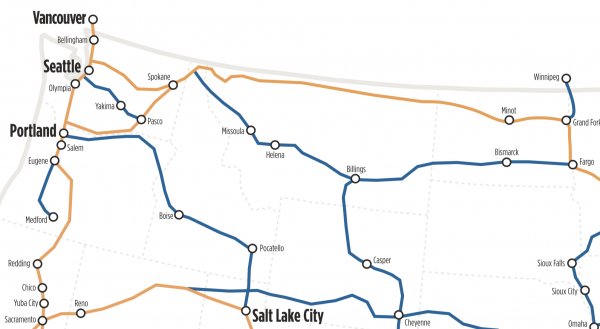
Pacific Northwest Corridor
Portland - Seattle - Vancouver
Core Express
The Pacific Northwest Corridor, one of the eleven federally designated higher-speed rail corridors in the United States, extends 466 miles from Eugene, Oregon to Vancouver, British Columbia, passing through Portland, Oregon and Seattle, Washington.
Washington State and Oregon envision high-speed trains operating at 200+ mph to create a stronger, better connected economic megaregion, and open up economic opportunities to people across the PNW. [VOTE NOW]
---
Pioneer
Seattle - Portland - Boise - Salt Lake City
Daily
When the Pioneer was established in June of 1977, it operated from Salt Lake City and Ogden to Seattle. At Ogden, Amtrak’s San Francisco Zephyr provided connecting service to/from Denver and Chicago for Pioneer route passengers. In 1983, Amtrak extended the Pioneer east from Ogden over the Union Pacific Railroad (UP) line through Wyoming (Overland Route) to connect with a rerouted California Zephyr in Denver.
Discontinued in 1997, restoring this route would connect one of the missing links in the National Network, expanding access to passenger rail in three of the fastest growing urban markets in the US and restoring intercity access to dozens of rural communities. [VOTE NOW]
---
North Coast Hiawatha
Chicago - Milwaukee - Minneapolis/St. Paul - Fargo - Helena - Missoula - Sandpoint - Seattle
Daily
The North Coast Hiawatha Route between Chicago and Seattle, running through southern Montana, was operated by Amtrak until 1979. Restoring the train would provide additional service to the heavily-traveled portions on the Chicago - Minneapolis/St. Paul and Washington State ends of the line. Concurrently, restoring train service to Fargo and Southern Montana, which features several universities, medical centers, and tourism sites. [VOTE NOW]
"On behalf of Amtrak’s onboard service staff, I want to thank the Rail Passengers Association for honoring their hard work with this award. The past couple years have indeed been difficult for Amtrak onboard service staff – coping with furloughs and job insecurity, adapting to changing protocols and services, not to mention the unfortunate events such as a tragic derailment and a fatal shooting. Nevertheless, our dedicated members at Amtrak have handled these hurdles with the care, attention and diligence for which they’re known. We thank Rail Passengers for their acknowledgement of our members’ hard work and, as always, look forward to seeing you on the rails."
Arthur Maratea, TCU/IAM National President
December 21, 2021, on the Association awarding its 2021 Golden Spike Award to the Frontline Amtrak Employees.
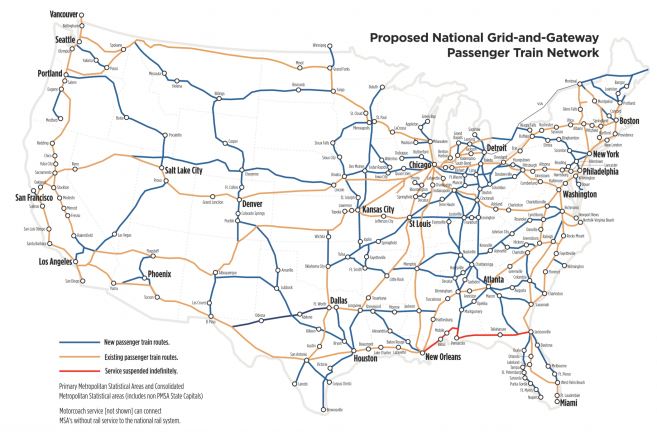
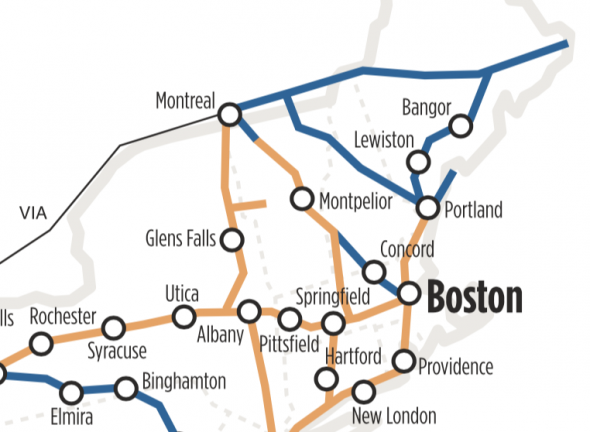
Comments